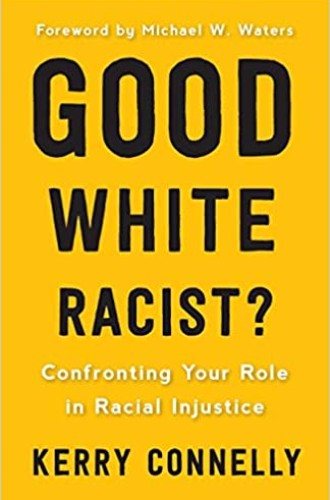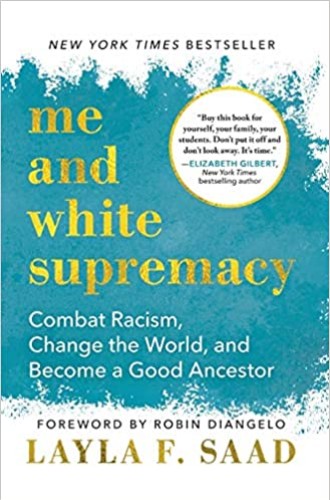Want to challenge White supremacy? Here’s a good place to start.
Kerry Connelly and Layla F. Saad offer primers for White people in various stages of antiracism journeys.
Like many White Americans, I was raised without an awareness of my racial identity. In early adulthood, an intensive antiracism workshop awakened me to the Whiteness that has always been my companion—silent, invisible, and yet utterly formative. Both Kerry Connelly’s Good White Racist? and Layla F. Saad’s Me and White Supremacy are helpful companions for White people at various stages of an antiracism journey.
Connelly, a certified life coach and seminary student who writes from within the Christian tradition, describes her book as written “by a white person for white people.” Saad writes near the beginning of Me and White Supremacy, “I am an East African and Middle Eastern Black woman. I am a Muslim woman. I am a British citizen. I live in Qatar. And I speak, write, and teach to a global audience.” She addresses her book to “any person who holds white privilege,” a status that is more complex and nuanced than it seems. Saad’s book, which is based on a wildly popular Instagram challenge, guides readers through an intensive 28-day process of journaling and reflection.
For those just beginning antiracism work, these books offer a straightforward, unacademic introduction to basic concepts and terms. At the same time, both authors state unapologetically that their work is designed to make White readers feel uncomfortable. Saad predicts:
You will want to close the book, run away, and pretend you never heard of me. You will want to blame me, rage at me, discredit me, and list all the reasons why you are a good person and why you don’t need to do this work. That is a normal, expected response. That is the response of the white fragility and anti-Blackness lying inside.
Connelly takes a confrontational tone in an attempt to break through White readers’ attachment to our own “goodness” and our addiction to comfort. As she puts it, “good white racists are generally nice people who intellectually do not approve of racist behaviors but who practice them anyway.” She seeks to unveil the denial, defensiveness, and hypocrisy that keep White people from changing and keep White supremacy intact.
Both books delve into the ways White supremacy lives within individual White people, providing a mirror for us to perceive our personal participation in a systemic problem. As Saad puts it, “Many white people hear the words white supremacy and think That doesn’t apply to me.” However, she continues,
white supremacy is a system you have been born into. Whether or not you have known it, it is a system that has granted you unearned privileges, protection, and power. It is also a system that has been designed to keep you asleep and unaware of what having that privilege, protection, and power has meant for people who do not look like you. What you receive for your whiteness comes at a steep cost for those who are not white.
The power of both Saad’s and Connelly’s work is the incredible specificity with which they delve into how our everyday thoughts, feelings, and behaviors continue to reinforce White supremacy.
Connelly helps readers see how racism operates in our language, in education, policing, incarceration, church, popular culture, and personal relationships. For instance, she analyzes the reactions of White people to Colin Kaepernick taking a knee to protest police brutality. She explains how White supremacy influences us to engage in gaslighting, a form of psychological abuse:
Kaepernick and others who support his public protest are demonized for calling attention to a deadly racial issue, and the furious response is not just illogical, it intentionally misses the point. By avoiding Kaepernick’s stated reasons for protesting, Kaepernick’s critics view him as some sort of national traitor, as unpatriotic, and as a hater of anyone who has ever served in the military. This narrative is merely a constructed reality designed to steal attention away from the actual problem—deadly racism.
Connelly’s book was published a few months before the murder of George Floyd, which changed public perception of Kaepernick’s protest somewhat. However, this example still illustrates how gaslighting constructs our reality so that we avoid seeing racism.
Saad guides readers through a systematic examination of all the ways White supremacy shows up in the thoughts and actions of White people—including White fragility, White silence, anti-Blackness, cultural appropriation, color blindness, White centering, optical allyship, and many other behaviors. She prompts White folks to reflect by writing about our personal participation in these harmful dynamics.
A member of my congregation, a young White woman, told me she has now completed Saad’s journaling process twice and that her group of “nice White friends” (as she puts it) regularly engage in antiracism conversation using this resource as a starting point. She appreciates how Saad brings up aspects of racism in our everyday lives that she wouldn’t have noticed on her own, such as the adultification of Black children or the limited categories adult Black women are put in.
Since my initial conversion experience, I’ve come to believe that dismantling White supremacy is the lifelong responsibility of all White people. I’ve continued to read, learn, and participate in protests led by people of color. I’ve invited my mostly White congregation to confront racism and make reparations with as much honesty, vulnerability, and courage as I can muster. I live in a racially diverse neighborhood, where I walk and run, shop, and seek to know my neighbors. I have a multiracial family formed through adoption.
Still, what both of these books brought home to me is that I am a complete beginner when it comes to acting in the world in a way that is antiracist. Both Connelly and Saad helped me to see a thousand ways in which I fail to show up to interrupt White supremacy when my turn comes, even though more and more I can see how it operates.
As I worked through the journaling component of Me and White Supremacy, I found myself repeatedly naming “White silence” as one of my problematic behaviors. Saad observes,
White silence is anything but neutral. Rather, it is a method of self-protection and therefore also the protection of the dynamics of white supremacy. It protects you, the person with white privilege, from having to deal with the harm of white supremacy. And it protects white supremacy from being challenged, thereby keeping it firmly in place.
I certainly speak up in the pulpit. My silences usually happen in interpersonal interactions that take me by surprise. The other day, for instance, a church member used a blatant racial stereotype in my presence. I couldn’t quickly find words that felt right to explain my objection. I didn’t want to embarrass this person in front of others or come off as a know-it-all. I worried about creating a rift in our relationship. I had other stuff to do and wanted to get on with it.
The bottom line is that these are just excuses. Connelly and Saad help me see how often I prioritize my own comfort over what I know I must do to enact the racial justice I say I believe in.
A version of this article appears in the print edition under the title “Antiracism journeys.”






